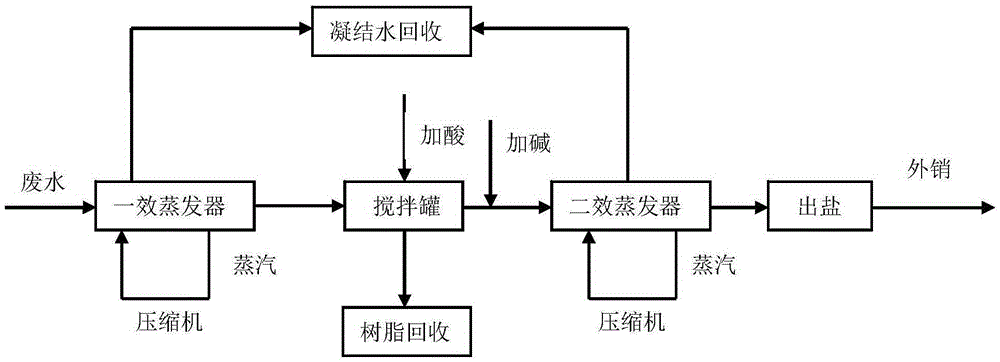Method for treating rubber vulcanization accelerator wastewater by combination of MVR (mechanical vapor recompression) evaporation and chemical treatment
A technology of rubber vulcanization and chemical treatment, applied in chemical instruments and methods, multi-stage water treatment, water/sewage treatment, etc. The effect of reducing COD in sewage
- Summary
- Abstract
- Description
- Claims
- Application Information
AI Technical Summary
Problems solved by technology
Method used
Image
Examples
Embodiment 1
[0019] Raw water is rubber vulcanization accelerator CZ waste water:
[0020] (1) Evaporation of raw water: the raw water is heated to 80°C by a first-effect evaporator to evaporate the salt concentration to 15%.
[0021] (2) Organic matter removal: add 31% hydrochloric acid to nearly saturated water to adjust pH=1, mix, stir and settle for 30 minutes, and collect the solid resin through a filter press.
[0022] (3) Neutralization: Add 32% liquid caustic soda to the incoming water with pH=1 to adjust pH=6 and enter the second-effect evaporator.
[0023] (4) The treated incoming water enters the second-effect evaporator to evaporate and crystallize 1.1 tons of salt.
[0024] The steam condensed water COD collected by the first-effect evaporator and the second-effect evaporator is directly used for reuse of workshop production water at 500 mg / L to obtain white sodium chloride salt with a salt content of 98.5%.
Embodiment 2
[0026] Raw water is rubber vulcanization accelerator NS wastewater:
[0027] (1) Evaporation of raw water: the raw water is heated to 90°C by a first-effect evaporator to evaporate the salt concentration to 20%.
[0028] (2) Resin precipitation: Add sulfuric acid to nearly saturated water to control pH = 3, mix, stir and settle for 45 minutes, and collect the solid resin through a filter press.
[0029] (3) Neutralization: add calcium hydroxide to the incoming water with pH=3 to adjust the pH=7 and then enter the second-effect evaporator.
[0030] (4) The treated incoming water enters the second-effect evaporator to evaporate and crystallize 1.3t of salt.
[0031] The COD of the steam condensate collected by the first-effect evaporator and the second-effect evaporator is directly used at 550mg / L for reuse of production water in the workshop to obtain white sodium chloride salt with a salt content of 98.9%.
Embodiment 3
[0033] Raw water is rubber vulcanization accelerator DZ waste water:
[0034] (1) Evaporation of raw water: the raw water is heated to 100°C by a first-effect evaporator to evaporate the salt concentration to 25%.
[0035] (2) Resin precipitation: Add 31% hydrochloric acid to nearly saturated water to control pH = 5, mix, stir and settle for 60 minutes, and collect the solid resin through a filter press.
[0036] (3) Neutralization: Add 32% liquid caustic soda to the incoming water with pH=5 to adjust pH=8 and then enter the second-effect evaporator.
[0037] (4) The treated incoming water enters the second-effect evaporator, evaporates for 3 hours, obtains a saturated solution, and crystallizes out 1.7t of salt.
[0038] The COD of steam condensate collected by the first-effect evaporator and the second-effect evaporator is 601mg / L, which is directly used for reuse of workshop production water to obtain white crystalline salt with a salt content of 98.1%.
PUM
 Login to View More
Login to View More Abstract
Description
Claims
Application Information
 Login to View More
Login to View More - R&D
- Intellectual Property
- Life Sciences
- Materials
- Tech Scout
- Unparalleled Data Quality
- Higher Quality Content
- 60% Fewer Hallucinations
Browse by: Latest US Patents, China's latest patents, Technical Efficacy Thesaurus, Application Domain, Technology Topic, Popular Technical Reports.
© 2025 PatSnap. All rights reserved.Legal|Privacy policy|Modern Slavery Act Transparency Statement|Sitemap|About US| Contact US: help@patsnap.com

